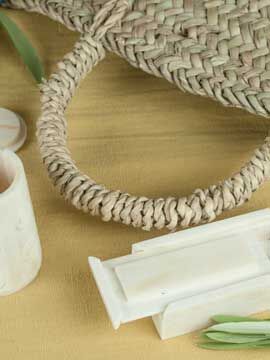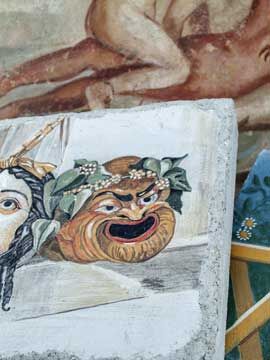House & Living
Roman furniture for your home
The Roman Villa
Rich Romans lived in elegant villas. This included an open courtyard called an atrium. In the centre was a basin to catch the rain and keep the room cool, called the impluvium. Around it were the bedrooms (cubiculum) and dining rooms. The dining room was called the triclinium. The Romans ate there very comfortably, half lying down. A passage led to a courtyard with a garden (peristylium). It was surrounded by a portico. The walls were artistically painted and the floor was usually decorated with mosaics. Some of these mosaics have been found in Pompeii.
Spartan furnishings
The Romans usually had few pieces of furniture in their rooms, which were usually windowless because of the Italian heat. Beds, sofas for eating, small tables and chests. Oil lamps or candles were used for lighting. But they did not give much light!
Pets
The Romans also liked to keep pets, for example dogs as watchdogs. A famous inscription found in Pompeii reads Cave canem - Beware of the dog!
Insula - the tenement house
Not all Romans were rich and had their own villa! Most Romans lived in a tenement house, called an insula in Latin. These Roman tenements were multi-storey buildings with many small flats. They were often badly built and sometimes collapsed! They often burned down when the residents cooked their food on small open fires. The fire brigade of the time - which already existed! - had their hands full. On the ground floor, the residents often had small shops facing the street where they sold food.
Water by the bucket
There was usually running water on the ground floor. It had to be carried upstairs in buckets. There was no glass in the windows. The windows only had bars, which did not protect against the cold in winter. Sometimes there were wooden shutters.
Villa rustica - the Roman estate
The villa rustica, or Roman estate, consisted of the landowner's residential buildings, sometimes a separate bathhouse, and, depending on the type of farming, rooms and facilities used for agriculture (sheds, stables, wine cellars). They were located near roads, rivers or canals so that the produce could be transported. Wine and olives were the main crops in central Italy, and cereals in Sicily. Vegetables, fruit and flowers were also grown and sold. Near Rome, the cultivation of flowers was particularly important, as they were used to decorate the many private and religious festivals. The Romans introduced cherries, apricots and peaches to Italy. They also bred pigs and cattle. Another Roman delicacy was poultry and songbirds. Cranes and peacocks were also kept on the estates. From the 1st century BC, the Romans began to breed wild animals (hares, deer, wild boar). Estates near the sea had ponds for breeding fish, especially sea fish. It was a lucrative business, as oyster farming near Naples proved. In the hinterland of the Limes or near forts, the villa rustica was also used to supply the legionaries and other soldiers and units stationed there.
Villa urbana - domus for the leisure time of rich Romans
The villa urbana was a kind of holiday home for wealthy and influential Romans from the 2nd century BC onwards. These Roman dwellings were usually more spacious than town houses. The villas were often built on hilltops. Hills and capes were popular sites. The landscape was incorporated into the construction of the houses. Garden architects planned individual sections of land so that they were particularly beautiful from the window. Ponds and waterscapes, as well as mythological landscapes, were very popular with the Romans at this time. The section then resembled an elaborate painting. Each villa also had a garden. There were trees and shrubs, vine-covered pergolas for a cool stroll, and fountains for cooling off.
But the villas also served cultural purposes. Rich Romans had space for their art collections and libraries. They even staged plays!
Roman utensils - just beautiful!
Incense burners, dried plants and herbs - also for medicinal purposes - were a staple of Roman life. Simple bowls made of wood and clay are modelled on Roman finds - collar bowls, lion's head jars or rubbing bowls for mortaring herbs and spices can be discovered according to Roman models. In this case, simple means not only unobtrusive, but also unobtrusively decorative and, above all, ready for use. The Roman flint creates the embers and the tinder blazes! Wooden crates or woven baskets made from ancient models also give the modern villa a touch of antique charm.
Hier noch einmal alle Kategorien im Bereich Wohnen
Schools and authorities in DE can conveniently order on account. Private customers are welcome to use Ratepay purchase on account (Paypal service)
Safe and easy ordering within Germany from 75 €
Always new ideas and optimised products through our years of experience and intensive cooperation with schools and museums.



